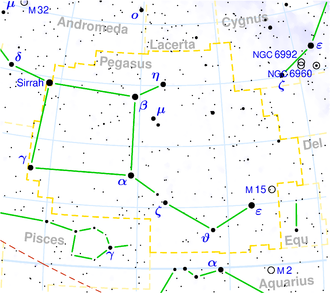NGC 7485
| Galaxy NGC 7485 |
|
|---|---|

|
|
| SDSS recording | |
| AladinLite | |
| Constellation | Pegasus |
|
Position equinox : J2000.0 , epoch : J2000.0 |
|
| Right ascension | 23 h 06 m 04.8 s |
| declination | + 34 ° 06 ′ 28 ″ |
| Appearance | |
| Morphological type | S0 |
| Brightness (visual) | 13.2 mag |
| Brightness (B-band) | 14.2 mag |
| Angular expansion | 1.2 ′ × 0.6 ′ |
| Position angle | 146 ° |
| Surface brightness | 12.7 mag / arcmin² |
| Physical data | |
| Redshift | 0.019033 ± 0.000190 |
| Radial velocity | 5706 ± 57 km / s |
|
Stroke distance v rad / H 0 |
(264 ± 19) · 10 6 ly (81 ± 5.7) Mpc |
| history | |
| discovery | John Herschel |
| Discovery date | August 19, 1828 |
| Catalog names | |
| NGC 7485 • UGC 12360 • PGC 70470 • CGCG 515-024 • MCG + 06-50-022 • 2MASX J23060487 + 3406278 • LQAC 346 + 034 002 | |
NGC 7485 is a lenticular galaxy of the Hubble type S0 in the constellation Pegasus in the northern sky . It is estimated to be 264 million light years from the Milky Way and about 90,000 light years in diameter.
The object was discovered by John Herschel on August 19, 1828 .
